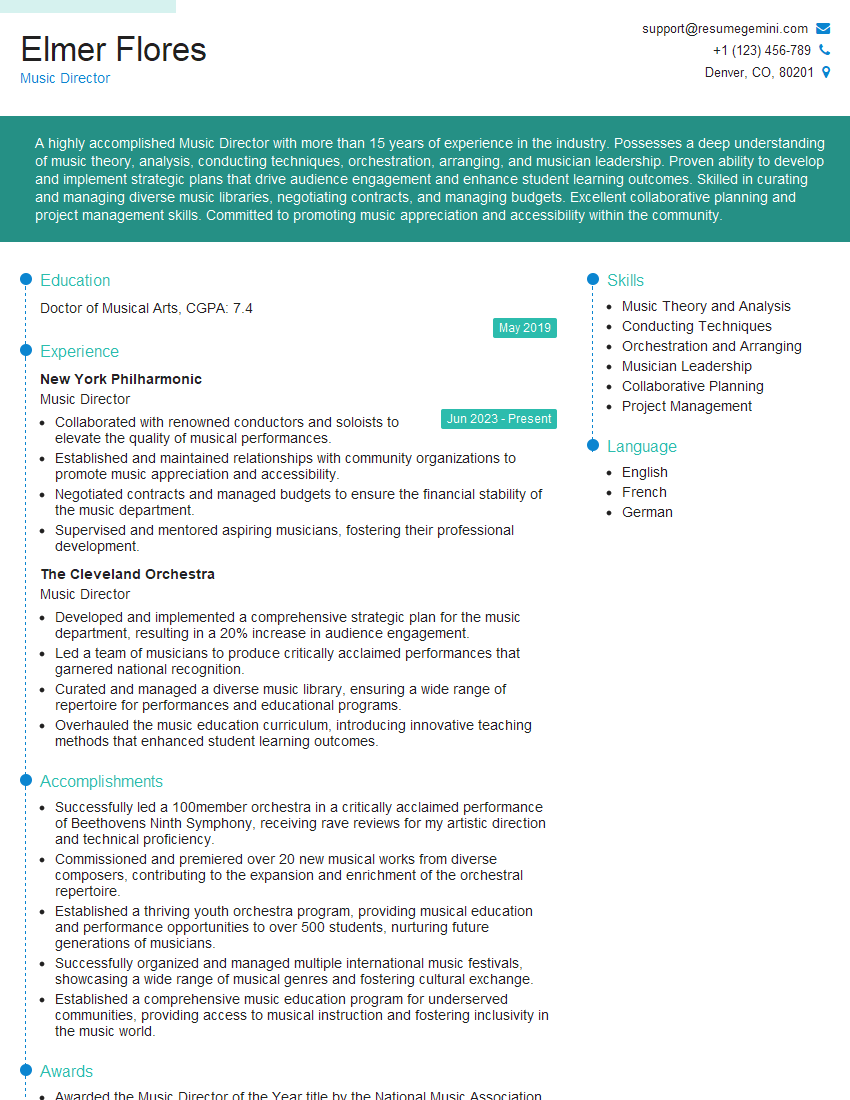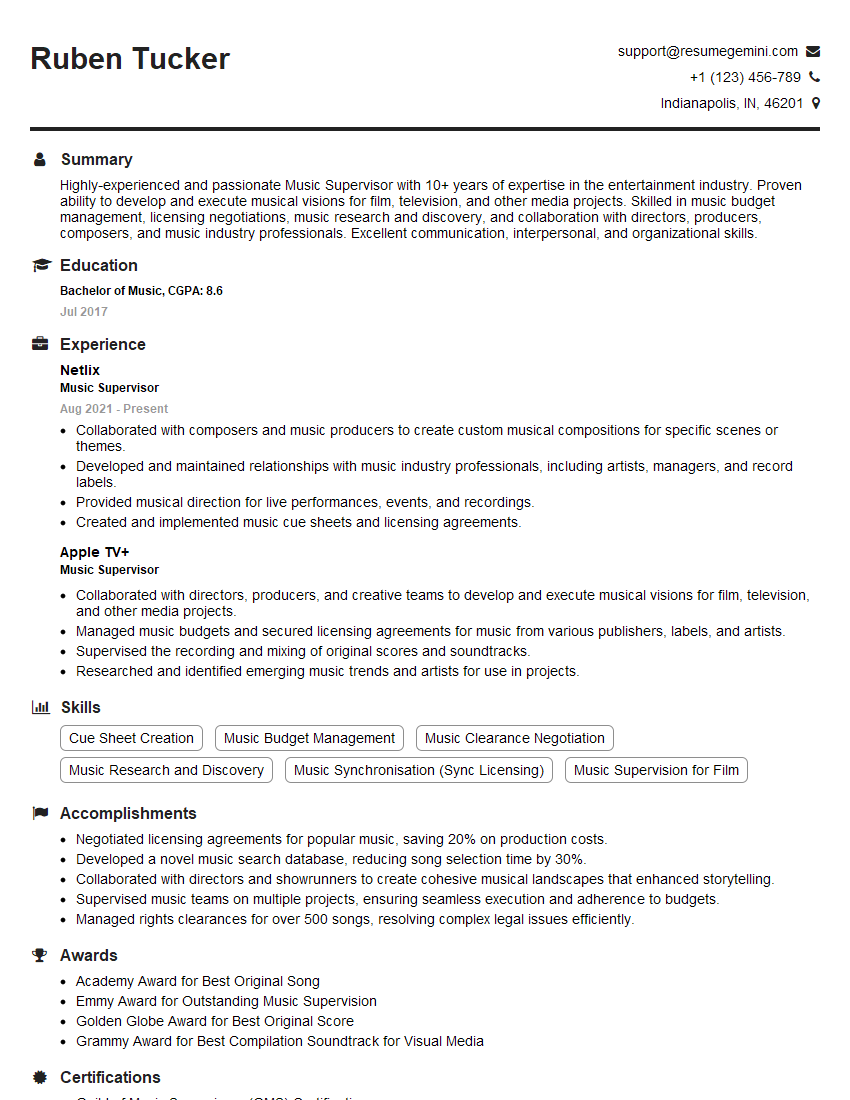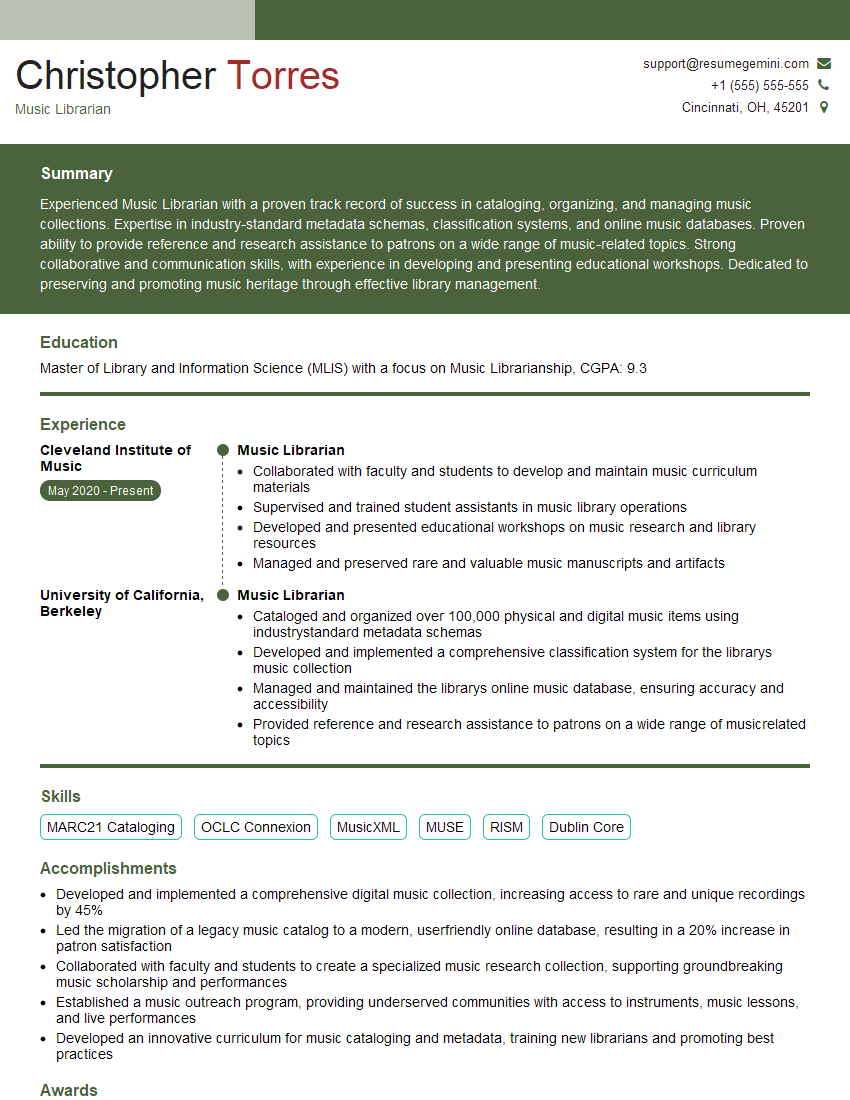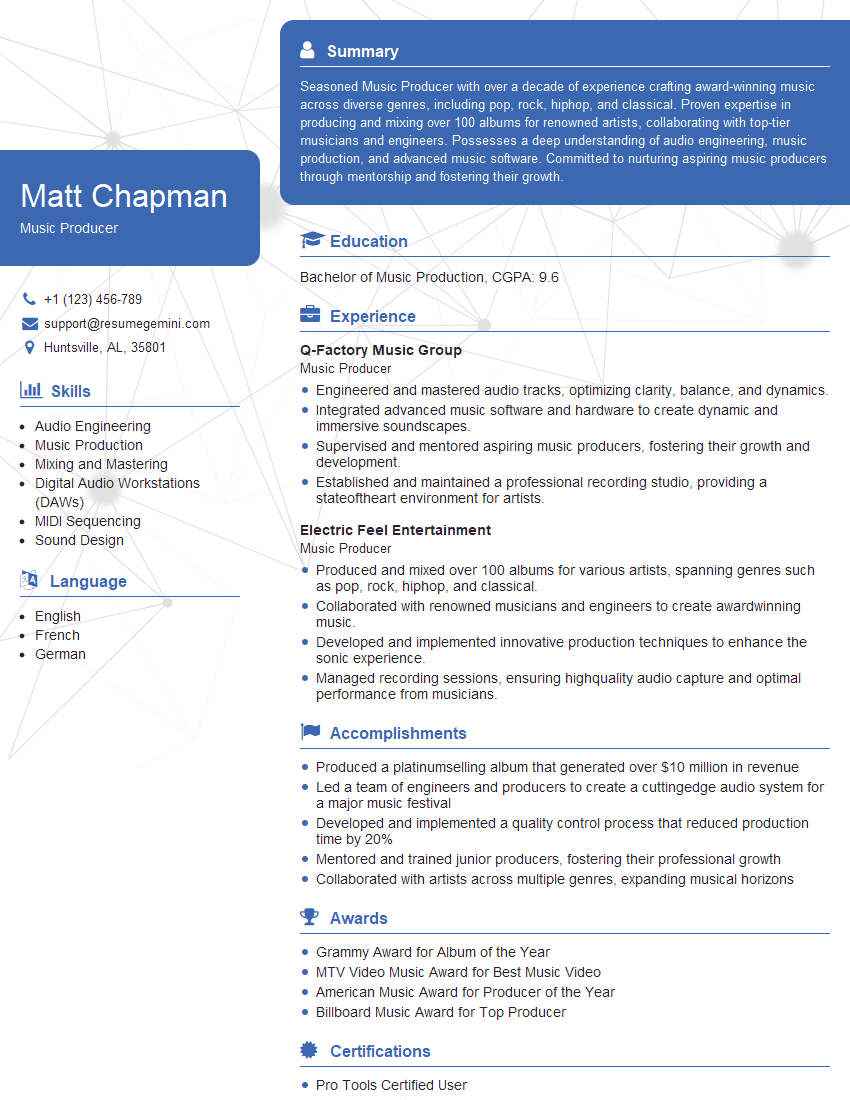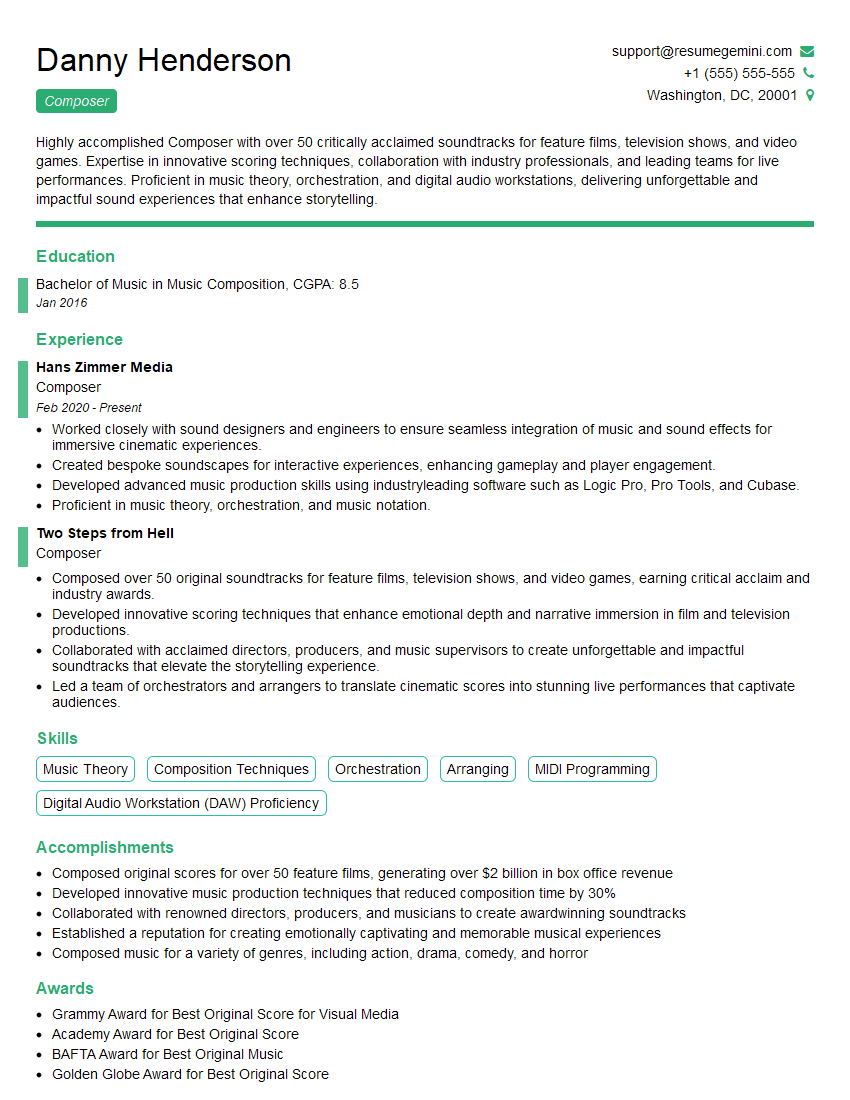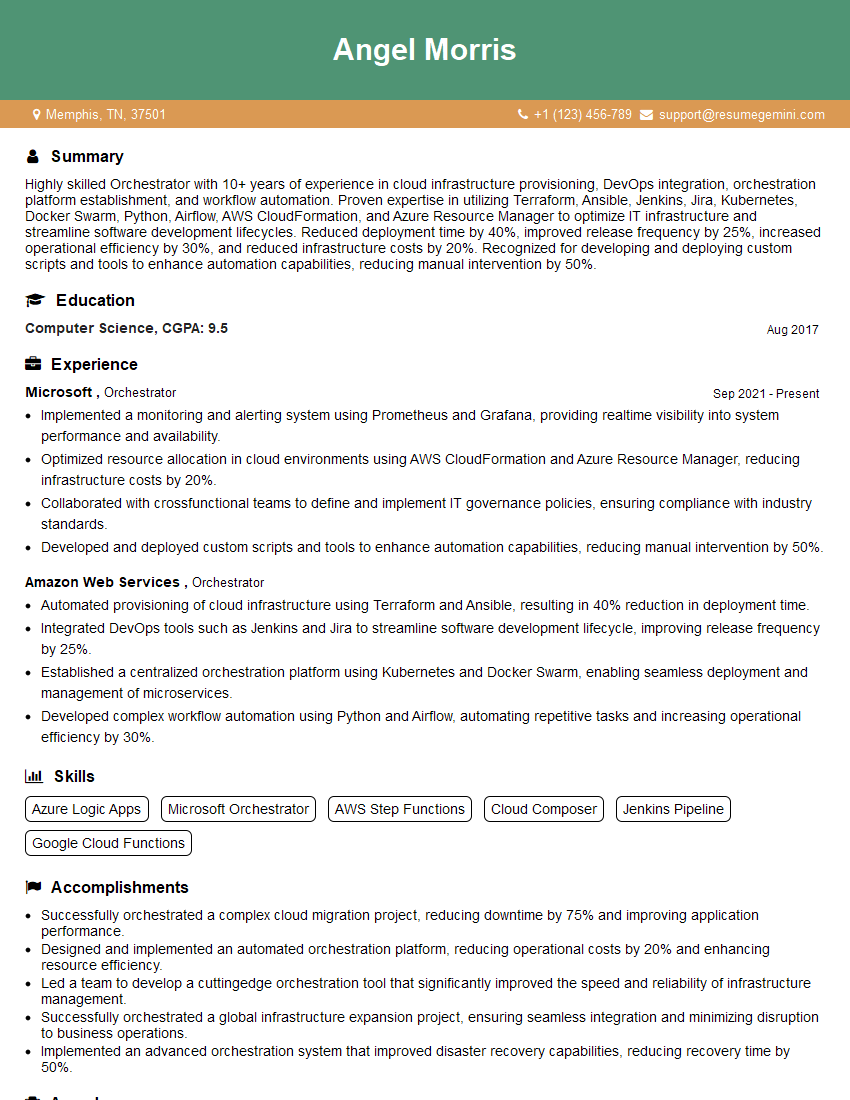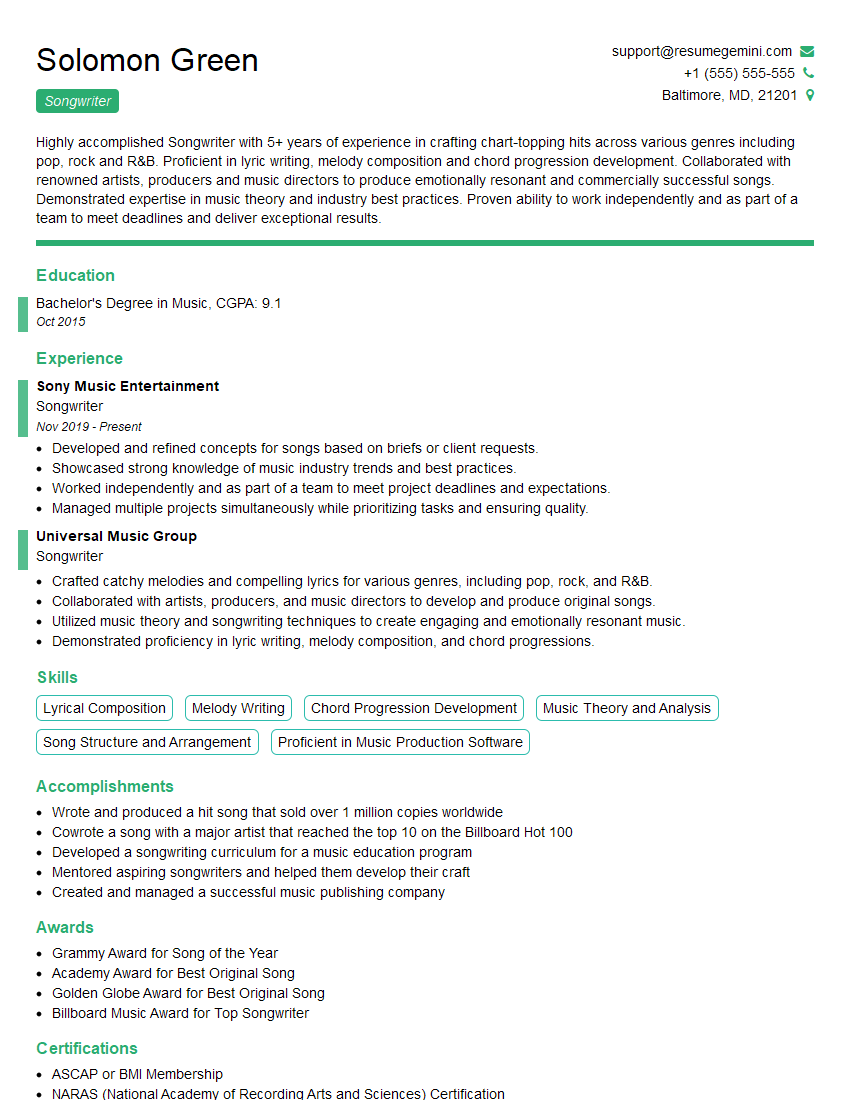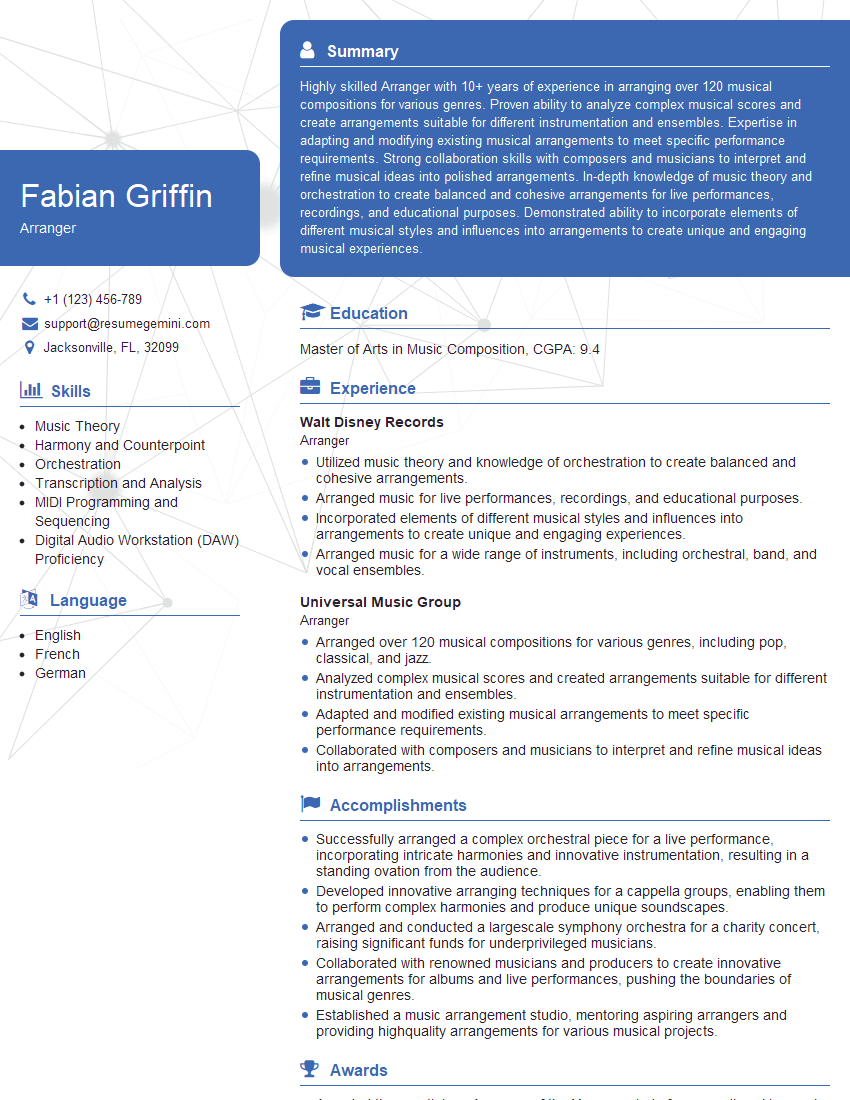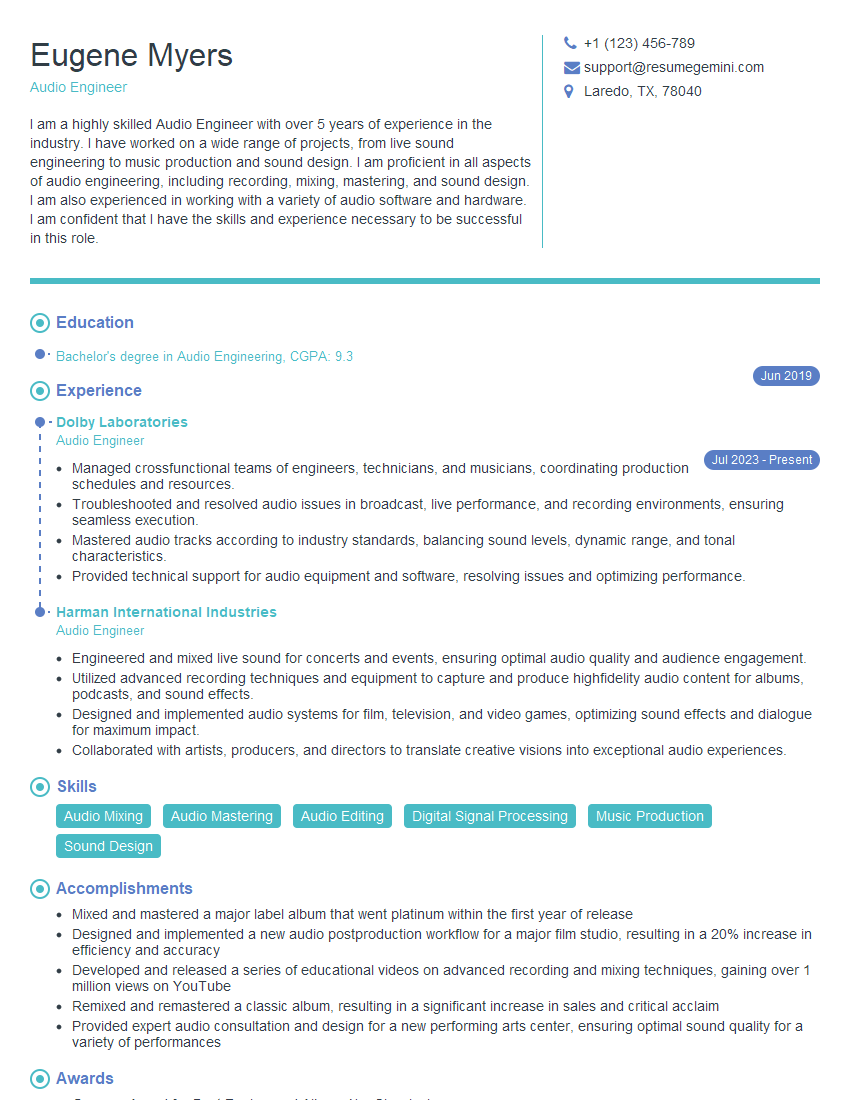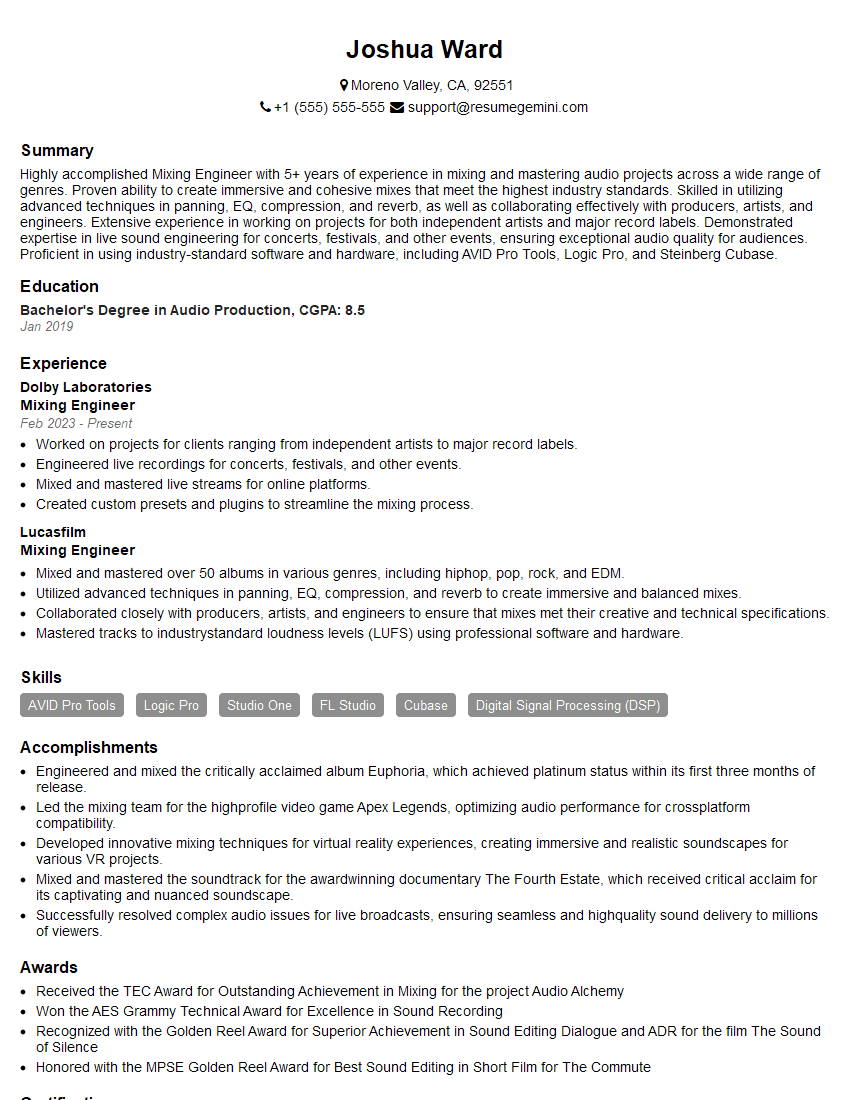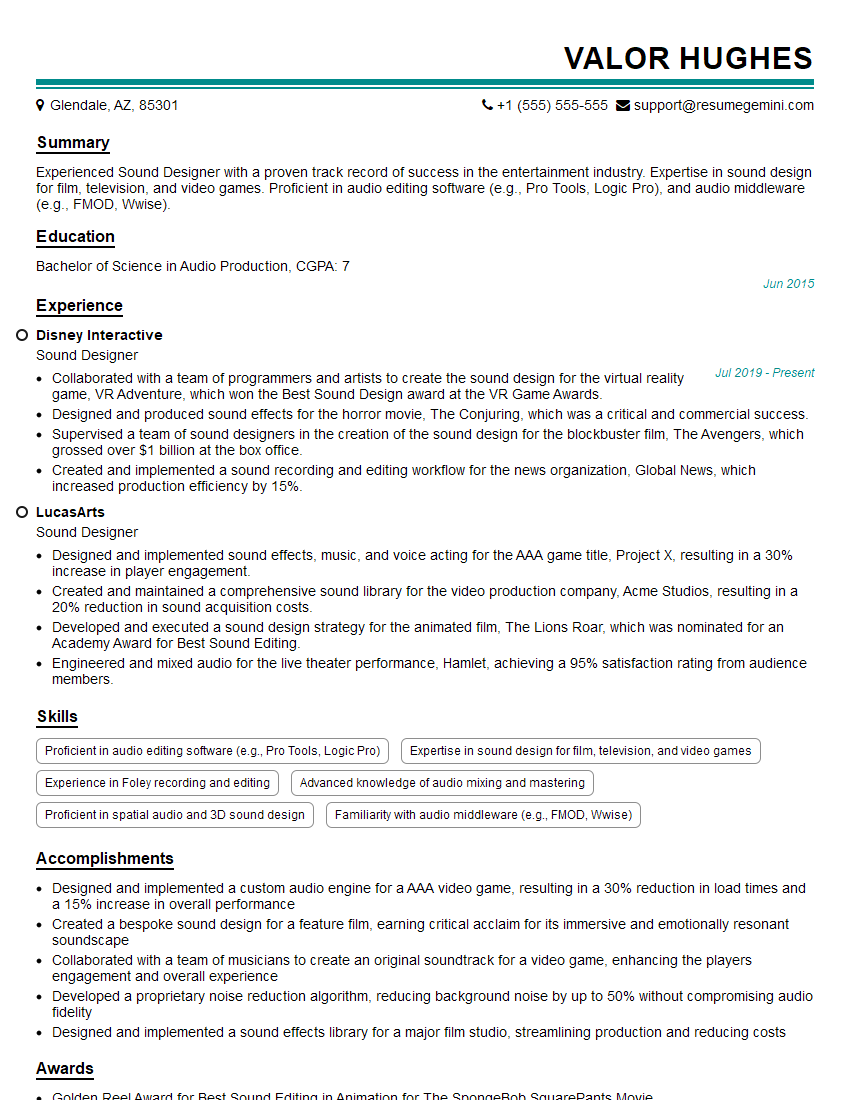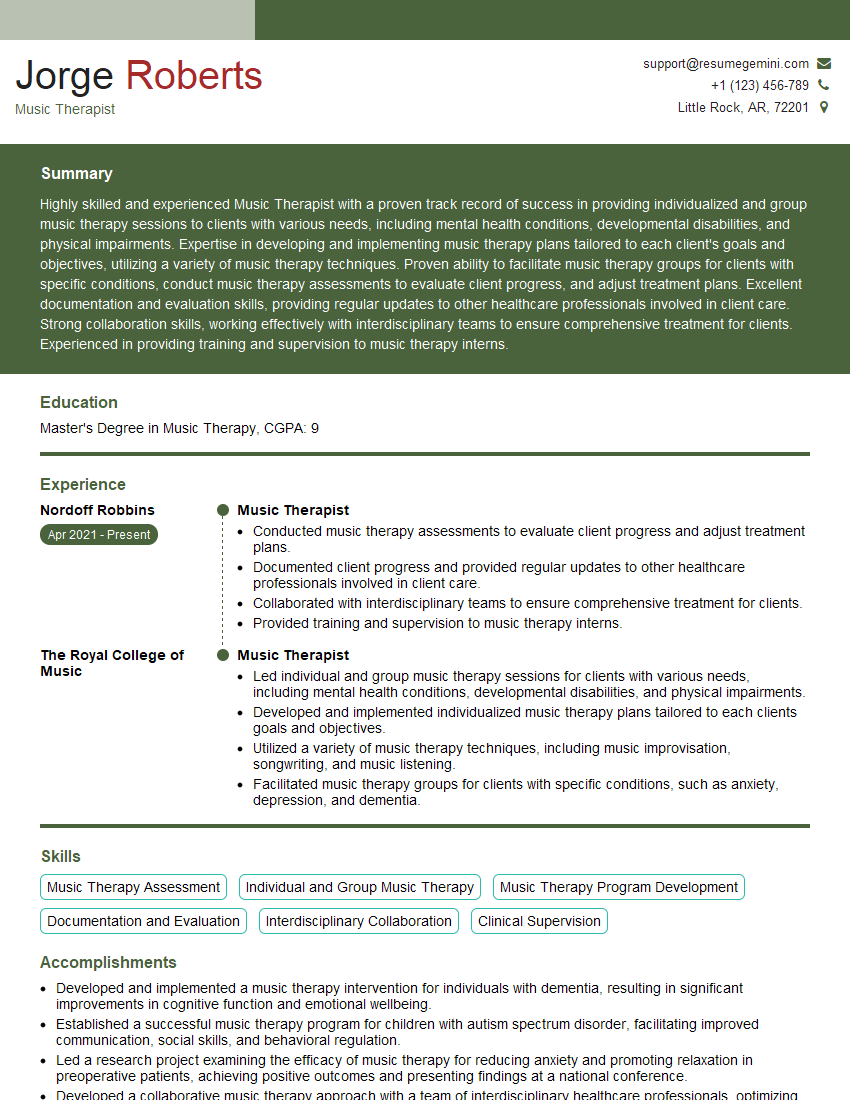Every successful interview starts with knowing what to expect. In this blog, we’ll take you through the top Collaborative Music Making interview questions, breaking them down with expert tips to help you deliver impactful answers. Step into your next interview fully prepared and ready to succeed.
Questions Asked in Collaborative Music Making Interview
Q 1. Describe your experience working collaboratively on a music project.
Collaborating on music projects is a dynamic process demanding a blend of technical skill, creative vision, and interpersonal communication. One project I particularly remember involved composing an orchestral piece for a video game. We had a team of five: a composer (myself), two instrumental arrangers, a sound designer, and a project manager. We initially outlined the emotional arc of the game’s key scenes, translating that into musical themes. Each team member then worked on their assigned sections, using a shared online platform to track progress and provide feedback. The arranger specializing in strings would, for example, focus on the emotional intensity for a particular scene, while the brass arranger would create a counterpoint reflecting a sense of tension. We utilized iterative reviews, sharing drafts and providing feedback on a regular basis which helped us avoid major conflicts later on. This iterative approach ensured our individual contributions harmonized into a cohesive whole, ultimately creating a dynamic and emotive soundtrack.
Q 2. What software and hardware are you proficient in for collaborative music production?
My proficiency spans a range of digital audio workstations (DAWs) and collaborative platforms. I’m highly experienced with Ableton Live, Logic Pro X, and Pro Tools for recording, editing, and mixing. For collaborative efforts, I rely heavily on cloud-based platforms like Google Drive and Dropbox for sharing large audio files efficiently. I also utilize specialized platforms such as Splice Sounds for collaborative sample libraries, allowing various team members to easily share and integrate sounds. On the hardware side, I’m comfortable using a variety of MIDI controllers, audio interfaces, and microphones, adapting my setup to suit the specific needs of each project. My experience also extends to using hardware synthesizers and samplers for creating unique textures and sounds.
Q 3. How do you handle creative differences within a collaborative music team?
Creative differences are inevitable in collaborative projects, but they can be productive if managed constructively. My approach centers on open and respectful communication. First, I ensure everyone feels comfortable expressing their ideas freely. We establish a clear framework for decision-making early on; sometimes a simple vote works, other times, a designated team lead makes the final decision. We always try to find common ground by exploring the root cause of the disagreement. For example, a difference in tempo might actually reflect a contrasting interpretation of the emotional context of a piece, and this can be addressed by exploring different approaches.
Active listening and compromise are vital. I encourage team members to articulate their reasoning clearly, and I strive to understand their perspectives before offering counterarguments. This avoids defensiveness and promotes a collaborative problem-solving atmosphere. Finally, I believe that respecting individual artistic voices, even if they differ from the majority opinion, contributes significantly to a creative and collaborative environment.
Q 4. Explain your approach to providing constructive feedback in a collaborative setting.
Constructive feedback is a cornerstone of successful collaboration. My approach focuses on specificity and positivity. Instead of saying ‘this sounds bad’, I’d say something more precise like, ‘I think the rhythm in the second verse feels a bit rushed; perhaps slowing it down slightly would improve the flow and enhance the lyrical impact.’ This highlights the specific area needing improvement, and offers a concrete suggestion. I always frame my comments in terms of the project’s overall goals. For example, ‘In the context of the song’s overall melancholic mood, I think adding more reverb here would deepen the emotional impact’. I make sure to balance critical points with praise, highlighting aspects that work well. This encourages the team member and allows them to see the bigger picture, keeping morale high while improving the project’s quality. A collaborative feedback session with the whole team often clarifies points of disagreement and allows for a truly shared understanding of the project’s direction.
Q 5. Describe a time you had to adapt your workflow to accommodate others in a collaborative project.
During a recent project involving a live electronic music performance, my usual workflow relies heavily on precisely timed MIDI sequences and intricate software-based effects. However, one of the collaborators preferred a more improvisational approach and relied more on hardware synths. To accommodate this difference, I adjusted my workflow to incorporate more spontaneous elements. We created a hybrid setup, combining pre-programmed sections with designated free-improvisation periods. This required a flexible mindset on my part and a significant shift towards a more spontaneous approach, but ultimately resulted in a more dynamic and exciting performance. It highlighted the importance of adapting to various styles and preferences within a collaborative environment. We even adopted a ‘jam session’ approach once a week where we would experiment with different sounds and approaches, allowing more organic collaboration to happen.
Q 6. How do you ensure effective communication within a collaborative music team?
Effective communication is crucial. We establish clear communication channels from the outset. In the aforementioned orchestral project, we used a combination of regular in-person meetings, a dedicated project management software (Asana), and a shared online communication platform (Slack). We had weekly progress meetings where each team member updates the others on their progress and any challenges faced. Asana helped us track tasks and deadlines, ensuring transparency and accountability. Slack was perfect for quick questions and sharing smaller files. It’s crucial to foster a culture of open communication where team members feel comfortable raising concerns or seeking clarification without fear of judgment. Regular check-ins, even short ones, go a long way toward keeping everyone on the same page.
Q 7. What strategies do you use to manage deadlines and expectations in a collaborative environment?
Managing deadlines and expectations in collaborative projects requires a proactive approach. We start by creating a detailed project timeline, breaking down large tasks into smaller, manageable ones with clearly defined milestones. This creates a sense of progress and allows for early identification of potential bottlenecks. Regular progress reviews help us track against this plan, identifying any delays early on. We use visual tools like Gantt charts to monitor progress. Open and honest communication regarding challenges is key – if a deadline looks unattainable, we discuss it openly to explore solutions, which may involve adjusting priorities or extending deadlines where necessary. Clear expectations are set from the outset about roles, responsibilities, and deliverables. This minimizes misunderstandings and ensures everyone is working towards the same goals, which contributes significantly to smoother completion within set timelines.
Q 8. How do you handle conflicts or disagreements during the collaborative music-making process?
Conflict is inevitable in collaborative music making, much like a jam session where individual styles clash initially. The key is proactive communication and a respectful approach. We address disagreements by first establishing clear communication channels – perhaps a dedicated project management platform or regular video calls. Then, we employ a structured approach: Active Listening: Each member gets a chance to fully express their ideas and concerns without interruption. Compromise and Negotiation: We explore different solutions, looking for common ground rather than focusing on winning or losing. This might involve modifying a section, experimenting with alternative arrangements, or even dividing tasks to allow individual creative expression within the larger framework. Mediation (if needed): If tensions remain, a neutral third party can facilitate discussion and help find solutions. For instance, if a disagreement emerges over the tempo of a section, we might try several versions and vote on which works best for the overall feel of the piece. Finally, documenting decisions and agreeing on a clear process for future disagreements is crucial for a healthy working relationship.
Q 9. What are your preferred methods for sharing and managing music files collaboratively?
Efficient file sharing is paramount. We utilize cloud-based collaborative platforms like Google Drive or Dropbox for storing and sharing high-resolution audio files (WAV or AIFF) and project files. Version control is essential; we might use a system like Google Drive’s version history or dedicated DAW (Digital Audio Workstation) features for tracking changes. For larger projects or those involving many collaborators, cloud-based collaborative DAWs such as Soundtrap or BandLab are highly effective. They allow for simultaneous editing and real-time feedback, fostering a seamless workflow. When using multiple platforms, clear labeling and a central organizational system are key to prevent confusion and ensure everyone can easily locate the latest versions.
Q 10. How do you maintain the overall artistic vision when collaborating with multiple artists?
Maintaining artistic vision with multiple artists requires a strong initial concept and clear communication. Before embarking on a project, we define the overall artistic direction – genre, mood, target audience, key thematic elements – and create a detailed project plan. This plan acts as a roadmap, guiding individual contributions toward a unified whole. Regular check-ins and feedback sessions are vital, ensuring everyone remains aligned with the project’s core vision. We use visual aids – mood boards, concept maps – to solidify our shared understanding. It’s also important to foster a collaborative environment where diverse perspectives are valued, allowing for organic evolution of the initial vision while maintaining its core integrity. A successful example would be establishing a common reference track at the outset, which is then adapted and refined by the collaborators.
Q 11. Describe your experience with version control systems in a music production context.
Version control is indispensable. While traditional version control systems like Git aren’t directly applied to audio files in the same way as code, the principles remain relevant. We leverage our DAW’s built-in versioning capabilities (e.g., saving different versions with descriptive names) or cloud-based collaborative platforms that automatically track changes. Consider this analogy: Imagine writing a song – each save is like committing a change in Git. We might have branches for experimenting with different melodic ideas or instrumental arrangements, merging them later once we’ve reached a consensus. A clear naming convention – ‘Version 1.0 – Initial Draft,’ ‘Version 1.1 – Bassline Revised’ – helps to keep track of changes and facilitates easy retrieval if needed. This method allows for easy rollback to previous versions if necessary, minimizing the risk of losing work.
Q 12. How familiar are you with different collaborative music platforms and tools?
I’m proficient with a variety of platforms. I’ve used cloud-based DAWs such as Soundtrap and BandLab extensively, appreciating their real-time collaboration features. For simpler projects or brainstorming sessions, Google Docs and Jamulus (for low-latency audio) are fantastic tools. I’m also familiar with more specialized collaborative platforms for specific tasks, such as Splice for sample libraries and collaborative composition tools designed for specific instruments or genres. My selection depends on the project’s specific needs, the number of collaborators, and the complexity of the music being produced. Choosing the right tool is like selecting the right instrument for a song; the wrong choice can hinder the creative process.
Q 13. What are some strategies for resolving technical issues during a collaborative session?
Technical hiccups are common; preparation is key. We begin by ensuring all collaborators have compatible software and hardware. A strong internet connection is crucial, especially for real-time collaboration. During a session, if a technical issue arises, we follow a structured approach: Identify the problem: Pinpoint the specific technical issue – audio dropouts, software crashes, connectivity problems. Isolate the cause: Is it a software bug, a hardware malfunction, or a network issue? Implement solutions: Try common fixes like restarting software, checking internet connections, or updating drivers. If the issue persists, we troubleshoot collaboratively, seeking input from other team members who might have experienced similar problems or have troubleshooting expertise. It’s also helpful to have backup plans – for instance, recording individual tracks separately if real-time collaboration becomes impossible. Documentation is important; logging technical issues and their solutions prevents similar problems in future sessions.
Q 14. How do you ensure that each team member’s contribution is valued and recognized?
Recognizing individual contributions is vital. We start by clearly defining roles and responsibilities from the project’s outset, ensuring everyone understands their unique contributions. Throughout the process, open communication and feedback are encouraged. We actively acknowledge individual strengths and celebrate creative breakthroughs. Formal recognition could include giving credit in the liner notes or on the album artwork, highlighting individual contributions on social media platforms or in project updates. Equitable compensation (if applicable) should also be considered, ensuring that each collaborator receives fair payment for their time and expertise. This approach fosters a positive and inclusive collaborative environment, motivating individuals and building strong team dynamics – a crucial element for successful collaborative music-making.
Q 15. What role do you typically take in a collaborative music project?
My role in a collaborative music project is multifaceted and depends on the project’s needs and the strengths of my collaborators. I’m comfortable taking on various roles, from primary composer or arranger to instrumentalist, producer, or even project manager. For instance, in one project, I focused primarily on songwriting and melody lines, while in another, I handled the mixing and mastering process, leveraging my technical skills. Ultimately, I adapt to the project’s requirements, ensuring that my contributions complement the talents of the team and drive the project forward effectively.
Career Expert Tips:
- Ace those interviews! Prepare effectively by reviewing the Top 50 Most Common Interview Questions on ResumeGemini.
- Navigate your job search with confidence! Explore a wide range of Career Tips on ResumeGemini. Learn about common challenges and recommendations to overcome them.
- Craft the perfect resume! Master the Art of Resume Writing with ResumeGemini’s guide. Showcase your unique qualifications and achievements effectively.
- Don’t miss out on holiday savings! Build your dream resume with ResumeGemini’s ATS optimized templates.
Q 16. How do you balance individual creativity with the needs of the collaborative team?
Balancing individual creativity with the collaborative team’s needs is crucial. It’s a delicate dance between expressing personal artistic vision and working towards a shared artistic goal. I achieve this through open communication and active listening. Before diving into individual creative components, we establish a clear project direction and overall sound aesthetic. This framework helps guide individual contributions while leaving space for creative exploration within those boundaries. For example, if the project aims for a specific genre, I’ll ensure my ideas align while still bringing my unique compositional style. Regular feedback sessions and respectful discussions help us integrate diverse ideas seamlessly.
Q 17. How do you handle situations where a collaborator misses deadlines?
Missed deadlines are a challenge in any collaborative project. My approach is proactive and empathetic. Firstly, I initiate open communication to understand the reason for the delay. Sometimes, it’s a genuine issue requiring support; other times, it might be a matter of prioritization. We then collaboratively readjust the timeline or, if necessary, redistribute tasks to ensure project completion. In cases of repeated issues, I’ll address the underlying problem through clear expectations and effective project management techniques, possibly involving a more structured project plan with milestones and check-in points.
Q 18. How do you contribute to a positive and productive collaborative environment?
Contributing to a positive and productive environment involves fostering trust, respect, and open communication. I encourage active participation from all team members, ensuring everyone feels heard and valued. This involves celebrating achievements, both big and small, and offering constructive criticism. Regular team meetings, even short informal check-ins, facilitate communication and prevent misunderstandings. I also focus on creating a space where experimentation and risk-taking are encouraged, knowing that not every idea will work, but that the creative process benefits from exploration. Ultimately, a collaborative environment thrives on mutual respect, support, and a shared vision.
Q 19. Describe your process for assigning tasks and responsibilities in a collaborative project.
Task assignment is a strategic process based on each collaborator’s strengths and the project’s requirements. We usually begin with a brainstorming session to outline all necessary tasks –composition, arrangement, recording, mixing, mastering, etc. Then, we discuss everyone’s skillset and preferences. This ensures tasks are assigned to individuals best equipped to handle them efficiently. We use project management tools to track progress and responsibilities, keeping everyone informed and updated. For instance, we might use a shared online document to list all tasks, assign individuals, and note deadlines. This transparency ensures accountability and a clear understanding of responsibilities for each team member.
Q 20. What are your strengths and weaknesses as a collaborative music-maker?
My strengths as a collaborative music-maker lie in my adaptability, open communication style, and technical proficiency in various aspects of music production. I am comfortable taking initiative, but also adept at working within a team’s dynamic. However, my weakness can be a tendency to overcommit sometimes, taking on too many tasks at once. I am actively working on improving my delegation skills to efficiently manage my workload and avoid burnout while still contributing my best to the project. I’ve found setting clear boundaries and using project management techniques help mitigate this.
Q 21. How do you stay organized and efficient when working on a complex collaborative project?
Staying organized and efficient in complex collaborative projects requires a structured approach. I rely heavily on project management tools, both digital and analog, depending on the project’s scale. This might involve using collaborative online platforms for file sharing, task management, and communication. We also create detailed project schedules with clear milestones and deadlines, ensuring everyone stays on track. Regular check-in meetings, detailed documentation, and version control for musical files are also crucial. By employing such strategies, we ensure clarity, accountability, and smooth workflow, resulting in a more efficient and enjoyable collaborative experience.
Q 22. How do you adapt your communication style to different collaborators?
Adapting my communication style is crucial for successful collaboration. I believe in tailoring my approach to each collaborator’s personality and preferred communication methods. For instance, some collaborators thrive on detailed email exchanges outlining every aspect of a project, while others prefer quick, concise updates through instant messaging. With more introverted collaborators, I might focus on creating a safe space for sharing ideas, offering ample time for reflection and thoughtful responses. Conversely, with more extroverted individuals, I might foster brainstorming sessions and encourage spontaneous feedback. Understanding individual communication preferences—be it visual, auditory, or kinesthetic—is vital. I constantly monitor the effectiveness of my communication and adjust accordingly, seeking feedback to ensure everyone feels heard and understood.
Q 23. Explain your approach to problem-solving in a collaborative music project.
My problem-solving approach in collaborative music projects is iterative and collaborative. It’s rarely a linear process. I start by clearly defining the problem. Is it a creative block? A technical issue? A conflict in vision? Once identified, I facilitate open discussion, encouraging each member to contribute their perspective. We brainstorm solutions using a combination of techniques like mind-mapping, SWOT analysis, or even simply free-flowing idea generation. We then evaluate the feasibility and potential impact of each proposed solution, considering factors like time constraints, budget, and technical limitations. The chosen solution is implemented, tested, and iteratively refined based on the results. Open communication and a willingness to adapt are key; sometimes a solution might require a compromise, or even a complete shift in direction. A recent project involved resolving a conflicting rhythmic approach. Instead of forcing one idea, we integrated both rhythms, creating a unique and unexpected result.
Q 24. How do you ensure that the final product reflects the collaborative efforts of the team?
Ensuring the final product reflects the team’s collaborative effort involves a multi-stage process that emphasizes transparency and ownership. Throughout the project, I document all contributions, outlining individual roles, ideas, and revisions. This documentation might take the form of detailed project management software, shared online documents, or a meticulously maintained log. Regular check-ins, both formal and informal, are crucial for continuous feedback and ensuring alignment with the overall vision. Creative differences are handled through constructive criticism, open debate, and ultimately, a democratic process where everyone has a voice in the final decisions. We might use voting systems for crucial decisions, and I make sure to celebrate and acknowledge every member’s contribution during the final presentation and release. This ensures that everyone feels valued and that their efforts are recognized in the final outcome.
Q 25. Describe your experience with remote collaboration in music production.
Remote collaboration has become integral to my workflow. My experience relies heavily on utilizing digital audio workstations (DAWs) like Ableton Live or Logic Pro, coupled with cloud-based collaboration tools. We use platforms like Dropbox, Google Drive, or dedicated music collaboration platforms to share files and projects. Asynchronous communication tools like email and project management software keep everyone informed. However, the key to success lies in establishing clear communication protocols and project timelines upfront. Regular video conferencing calls are essential, not only for project updates but also for maintaining a sense of team cohesion. I’ve found that scheduling dedicated ‘jam sessions’ virtually can also significantly boost creativity and collaboration. Challenges can arise with latency issues or technical difficulties, so having backup plans and understanding each team member’s technical capabilities is essential.
Q 26. How do you handle feedback from clients or other stakeholders in a collaborative project?
Handling feedback requires active listening, empathy, and a professional approach. I begin by thanking the client for their feedback, acknowledging its value. I then analyze the feedback carefully, distinguishing between constructive criticism and subjective opinions. For constructive criticism, I collaboratively explore solutions, explaining the technical limitations or creative choices behind specific decisions. For subjective opinions, I carefully explain the artistic rationale, offering alternative perspectives. The goal is not necessarily to always implement the feedback directly, but to engage in a dialogue that clarifies the client’s needs and expectations while maintaining artistic integrity. It’s about finding a balance between client satisfaction and creative vision. I document all feedback and revisions, ensuring that the final product reflects a considered response to all input.
Q 27. What are your strategies for building trust and rapport with collaborators?
Building trust and rapport begins with clear and open communication. I strive to create a welcoming and inclusive environment where everyone feels comfortable sharing their ideas, concerns, and vulnerabilities. Starting with introductory meetings where collaborators can get to know each other personally is beneficial. Early on, I emphasize mutual respect, shared goals, and a commitment to open feedback. Actively listening to each collaborator’s needs and perspectives demonstrates respect and builds trust. Celebrating both big and small successes along the way reinforces the team dynamic and positive feelings. Honesty and transparency about challenges, as well as consistent communication, reinforce trust. For instance, proactively addressing potential conflicts or addressing delays with honesty strengthens the team’s confidence in my leadership and their shared project.
Q 28. How do you measure the success of a collaborative music project?
Measuring success in a collaborative music project goes beyond simply the financial outcome. While sales figures, streams, and royalties are important metrics, I also consider artistic merit, audience reception, and the overall collaborative experience. I measure success based on achieving the project goals that we defined at the outset – did we fulfill the client’s brief? Did we creatively achieve what we set out to do? I also analyze audience feedback through reviews, social media engagement, and live performances. Importantly, the team’s satisfaction and sense of accomplishment are crucial indicators of success. A project where the team felt valued, creatively fulfilled, and worked well together can be considered a success even if it doesn’t achieve mainstream popularity. This holistic approach ensures a balanced assessment of the project’s overall impact.
Key Topics to Learn for Collaborative Music Making Interview
- Understanding Collaborative Processes: Explore different models of collaborative music creation, including co-writing, collective improvisation, and remote collaboration. Consider the impact of various communication styles and technologies.
- Technological Proficiency: Demonstrate familiarity with relevant software (DAWs, notation software, collaborative platforms) and hardware (audio interfaces, MIDI controllers). Be prepared to discuss your experience using these tools effectively in a collaborative setting.
- Effective Communication and Teamwork: Discuss strategies for clear communication within a team, including active listening, constructive feedback, conflict resolution, and efficient workflow management. Practice articulating your creative vision and responding to the ideas of others.
- Copyright and Legal Aspects: Understand the legal frameworks surrounding collaborative music projects, including copyright ownership, licensing agreements, and credit allocation. This demonstrates professionalism and a responsible approach to creative work.
- Creative Problem-Solving: Showcase your ability to overcome creative blocks, manage differing artistic visions, and adapt to unexpected challenges within a collaborative environment. Provide examples of how you’ve successfully navigated these scenarios.
- Musical Styles and Genres: Be prepared to discuss your experience working across various musical genres and styles. Demonstrate adaptability and understanding of diverse musical aesthetics.
- Project Management in Collaborative Settings: Discuss your experience with planning, scheduling, budgeting, and delivering collaborative projects. Highlight your organizational skills and ability to meet deadlines.
Next Steps
Mastering collaborative music making is crucial for career advancement in today’s interconnected music industry. It opens doors to diverse roles, from session musicianship and production to composing for film and game soundtracks. To maximize your job prospects, invest time in creating a strong, ATS-friendly resume that effectively showcases your skills and experience.
ResumeGemini is a trusted resource to help you build a professional resume that stands out. Leverage its tools to create a compelling narrative of your collaborative music making journey. Examples of resumes tailored to Collaborative Music Making are available to help guide you.
Explore more articles
Users Rating of Our Blogs
Share Your Experience
We value your feedback! Please rate our content and share your thoughts (optional).
What Readers Say About Our Blog
Hello,
We found issues with your domain’s email setup that may be sending your messages to spam or blocking them completely. InboxShield Mini shows you how to fix it in minutes — no tech skills required.
Scan your domain now for details: https://inboxshield-mini.com/
— Adam @ InboxShield Mini
Reply STOP to unsubscribe
Hi, are you owner of interviewgemini.com? What if I told you I could help you find extra time in your schedule, reconnect with leads you didn’t even realize you missed, and bring in more “I want to work with you” conversations, without increasing your ad spend or hiring a full-time employee?
All with a flexible, budget-friendly service that could easily pay for itself. Sounds good?
Would it be nice to jump on a quick 10-minute call so I can show you exactly how we make this work?
Best,
Hapei
Marketing Director
Hey, I know you’re the owner of interviewgemini.com. I’ll be quick.
Fundraising for your business is tough and time-consuming. We make it easier by guaranteeing two private investor meetings each month, for six months. No demos, no pitch events – just direct introductions to active investors matched to your startup.
If youR17;re raising, this could help you build real momentum. Want me to send more info?
Hi, I represent an SEO company that specialises in getting you AI citations and higher rankings on Google. I’d like to offer you a 100% free SEO audit for your website. Would you be interested?
Hi, I represent an SEO company that specialises in getting you AI citations and higher rankings on Google. I’d like to offer you a 100% free SEO audit for your website. Would you be interested?
good
